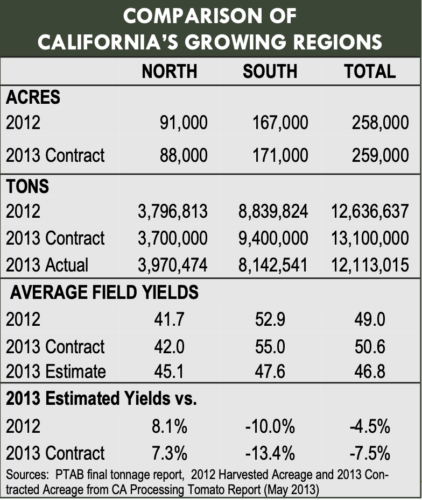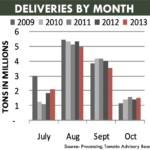 Curly Top sounds like the name of a plucky animal hero in a children’s story. But it’s not. Curly Top is a virus, lethal to plants, that wiped out a sizeable portion of California’s processing tomato crop this summer.
Curly Top sounds like the name of a plucky animal hero in a children’s story. But it’s not. Curly Top is a virus, lethal to plants, that wiped out a sizeable portion of California’s processing tomato crop this summer.
California produced 12.1 million tons of tomatoes but fell short of contract intentions by 7.5%. In May, growers were expecting a near-record volume, planning to deliver 13.1 million tons. How‐ ever, challenging weather (heat and wind) coupled with damage from Curly Top Virus created one million tons in losses.
All of California’s losses were in the southern Central Valley where the Curly Top outbreak hit extensively. (Please see our September Newsletter for details about the virus.) Official yield numbers won’t be released until January, but the south’s estimated yields were off 13.4% from expectations.
Meanwhile, tomatoes in the north enjoyed balmy weather and no damage from the virus. With yields estimated at 45.1 tons per acre, northern fields exceeded 2012 yields by 8.1% and likely broke records.
Unfortunately, because the southern region plants significantly more acres with higher yields, the impressive northern bounty was not large enough to recoup all the losses in the south.
As a result of the stricken crop, packers ran below capacity. The peak of the season was briefer and smaller than normal. Typically tomato deliveries exceed one million tons through August and September. This season, only the four weeks in August went over 1  million tons each, and deliveries began tapering in the first week of September. An unseasonable, heavy rain did hit the state but did little damage. Since packers were not running at capacity, harvesting was ahead of the crop and tomatoes held up well in fields.
million tons each, and deliveries began tapering in the first week of September. An unseasonable, heavy rain did hit the state but did little damage. Since packers were not running at capacity, harvesting was ahead of the crop and tomatoes held up well in fields.
October tonnage was larger than normal because growers had replanted some fields lost to Curly Top. The weather stayed pleasant allowing the season to end smoothly around October 18.
Despite the struggles, overall tomato quality was first‐rate, with bright color and Natural Tomato Soluble Solids averaging 5.23.

Morning Star Newsletter now distributed electronically
As a reminder, Morning Star is now distributing our newsletters electronically using an email distribution vendor called Mailchimp. Your e-version will now include informative Morning Star videos and highlights. Depending on your company's firewall, these emails may initially be directed to you spam folder.

